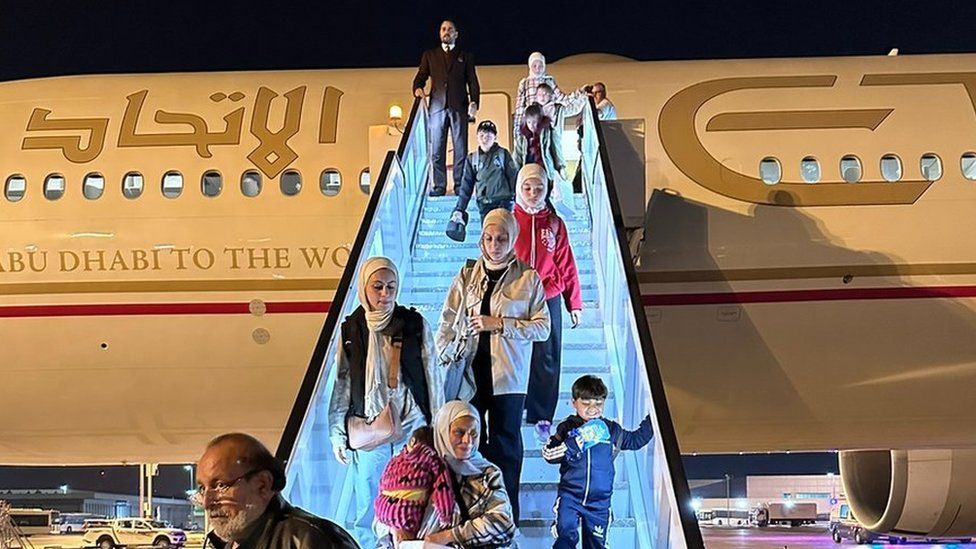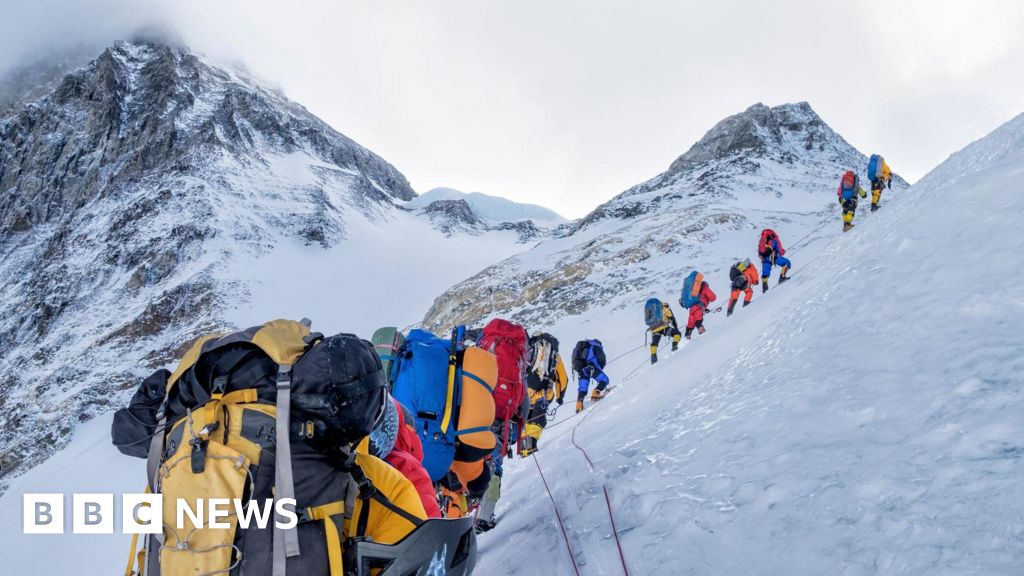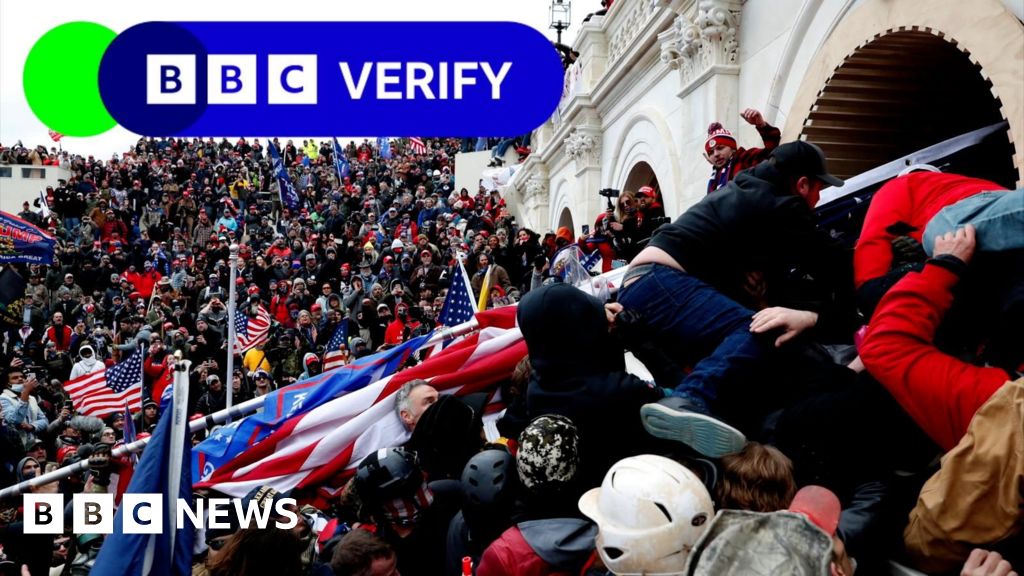ARTICLE AD BOX

Palestinians disembark an evacuation flight that has taken them from Egypt to the UAE
By Quentin Sommerville
BBC Middle East Correspondent
Two very different flights in 24 hours, each with the same aim: to alleviate Gaza's suffering.
The first is the less perilous: an Etihad Airways passenger plane, flight EY750 from Abu Dhabi, in the United Arab Emirates. The Boeing 777 has been converted into a virtual flying ambulance with seats in economy turned into hospital beds.
Its mission, paid for by the government of the UAE, is to return civilians who had previously got out after being trapped in Rafah in southern Gaza, in some cases for months, and to evacuate wounded Palestinian children who had crossed from Gaza to al-Arish in Egypt's northern Sinai.
After hours on the ground, the first evacuees start to make it on board. There is relief on their faces as they make it across the airfield to the plane, but uncertainty too. Many have left family members behind in Gaza.
Among them is 58-year-old Hanaa Hasan Abu Namous. Her hand is badly injured. She says 25 members of her family were killed in an Israeli air strike on their home in the Jabalia refugee camp in northern Gaza.
"During the war they were displaced," she tells me. "Thirty or 50 of them would come to our house. We are civilians. We never have and never will fight."
She holds a picture on her phone of shroud-wrapped bodies. They had to be buried together, four or five to a coffin, she says.
The plane evacuated Palestinian children who had crossed from Gaza into Egypt
Sitting a few rows forward is 13-year-old Yazan Wajih Barhum, whose left foot has been partially amputated. He was at a neighbour's house in Rafah when an Israeli bomb hit, he says.
His seven-year-old brother, Yamen, was hit with shrapnel in the eye and is already in Abu Dhabi. When I ask him when they last saw each other he answers, quick as a flash, "58 days ago". What are his hopes for the future, I ask.
"To be able to walk on my legs again, get back to how I was, play football with my friends, and for the war to end so I can go back to my country", he says.
The crew on board, regular airline staff, hand the 25 injured children backpacks with games and a SpongeBob blanket. The kids who are able sit watching cartoons on the entertainment system; some are on stretchers at the back of the plane.
Kiran Sadasivan, the cabin manager, welcomes the children and their chaperones on board, taking pictures with their phones and distributing meals. "This is my tenth mission flight," he tells me. "And I'll be on the next one in a few days."
Also on board is Dr Maha Barakat, the UAE's assistant foreign affairs minister. A UK-trained doctor, she does not rest during the 20-hour evacuation mission, checking on the patients and medical team and liaising with the Egyptian authorities on the ground.
"The actual day today was clearly a more challenging day than usual," she says. "There was a particular girl that we were trying to get through - she was in urgent medical need. And she wasn't able to make it to the border. However, we will have another plane coming in the next few days."
A member of the crew explains the plane's entertainment system to a Palestinian girl
Not all the Palestinians on the plane are leaving Gaza. Sitting alone, wearing a dark red headscarf and with a small leather handbag at her side is mother-of-three Zahra Mohammed Al-Qeiq. She has leukaemia, and left Gaza a few months ago for treatment in Abu Dhabi. Now she is returning to Rafah.
Isn't she scared, I ask her.
"The whole period I spent in the Emirates, my kids were crying on calls asking me to come back, saying 'come back; we will die in Gaza'. I had to stop my treatment and go back to my children," she says.
Emirati doctors have given her six months of chemotherapy drugs. "I cried every night I was away from home. I have to go back, they are my children," she says.
First UK aid airdrop
Twenty-four hours later, a Royal Jordanian Airforce cargo plane - "Guts Airline" painted on its side - heads for Gaza at sunset.
The aircrew on board have done this flight a dozen times. As they reach 17,000ft (5,200m), they put on oxygen masks and make final precise adjustments for the drop.
For the first time, the cargo on board is British: four tonnes of supplies, including fuel, medical gear and food rations, to resupply the Jordanian-run field hospital in Gaza City.
Watch: BBC onboard plane dropping UK aid into Gaza
Until now Britain has only sent aid by land and sea, but northern Gaza has become almost entirely unreachable. The World Food Programme has suspended deliveries there because its convoys have endured "complete chaos and violence", it said.
There is a heavy Israeli military presence on the ground. The Jordanian authorities will not disclose what co-ordination is made with Israel to allow the plane to fly overhead without incident.
Israel maintains a tight grip on the aid going into Gaza. Britain and others have complained that only a fraction of the aid needed is making it into the strip. Everything is subject to stringent Israeli checks, to prevent supplies making it inside that would aid Hamas.
Most of the people in this once densely packed part of Gaza have been driven out by Israeli forces, but some 300,000 remain, barely surviving in the most desperate of circumstances. The UN has been warning for months of the threat of famine in northern Gaza.
I watch as the cargo doors opened and the first two pallets of supplies fly off into the black night. The plane banks sharply and turns, and the second two pallets are launched. The Jordanian crew give a thumbs-up and head for home.
It is a small drop in the chasm of Gaza's need. But this aid sent into the night at least manages to get through; the crew confirms it has landed right on target.

 11 months ago
43
11 months ago
43








 English (US) ·
English (US) ·